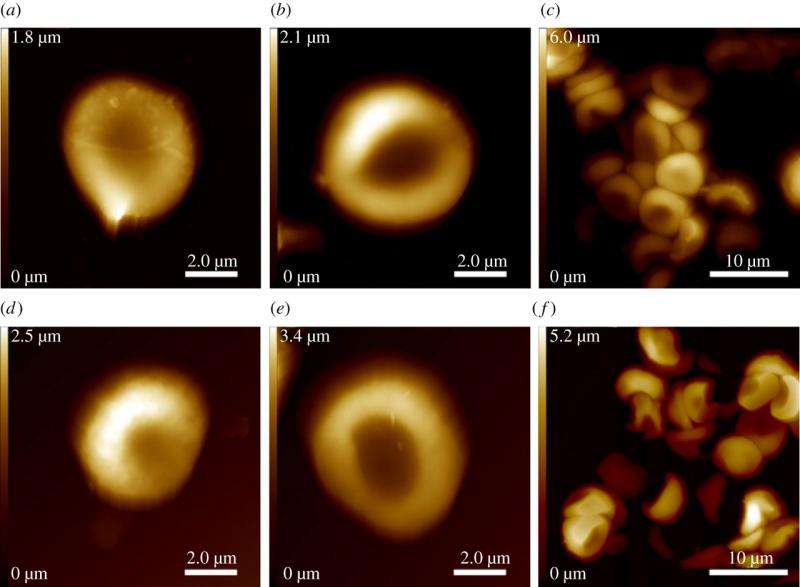May 8, 2015 report
New study of Iceman reveals oldest known example of red blood cells

(Phys.org)—A team of researchers with the European Academy of Bozen (EURAC) aka, the Institute for Mummies and the Iceman in Bolzano, Italy, has found examples of the oldest known samples of red blood cells. In their paper uploaded to the open access site, Journal of the Royal Society Interface, the team explains how they found the red blood cells and why they now believe the Iceman died very quickly.
The Iceman as he has come to be known, (also known as Ötzi) has been the object of intense scrutiny ever since being found embedded in an Alpine glacier back in 1991—he is believed to have died approximately 5,300 years ago. Attempts to find examples of actual red blood cells within his body have failed in the past, but in this new effort, the researchers used a new technique—a nano-sized probe they moved very slowly over parts of the mummified body that had been wounded, leading to open cuts. Because it moves, the probe allows for capturing 3D imagery—it revealed the clear doughnut shape of red blood cells. To confirm that the images they were seeing represented real red blood cells, the team shone a laser on the same material and read the wavelengths that were reflected back—that revealed that the molecular makeup of the material matched that of red blood cells—a finding that marks the oldest known preserved instance of a red blood cell.
Scientists believe the Iceman was approximately 46 years old when he died—other research has led to the discovery that he suffered from a variety of illnesses and injuries and his skin was decorated with many tattoos, most of which are believed to have been applied as a means of alleviating joint pain, possibly due to arthritis or inflammation caused by Lyme Disease.
Also, by using Raman spectroscopy, the researchers found traces of fibrin, a clotting agent the body makes immediately after an injury occurs, which suggests very strongly that the Iceman died shortly after he was wounded—it is generally absorbed shortly after an injury occurs as other agents take over. Because it was still present near the Iceman's wound suggests he died shortly after it was inflicted, likely from a blow to the head.
More information: Preservation of 5300 year old red blood cells in the Iceman, Journal of the Royal Society Interface, DOI: 10.1098/rsif.2012.0174
Abstract
Changes in elasticity and structures of red blood cells (RBCs) are important indicators of disease, and this makes them interesting for medical studies. In forensics, blood analyses represent a crucial part of crime scene investigations. For these reasons, the recovery and analysis of blood cells from ancient tissues is of major interest. In this study, we show that RBCs were preserved in Iceman tissue samples for more than 5000 years. The morphological and molecular composition of the blood corpuscle is verified by atomic force microscope and Raman spectroscopy measurements. The cell size and shape approximated those of healthy, dried, recent RBCs. Raman spectra of the ancient corpuscle revealed bands that are characteristic of haemoglobin. Additional vibrational modes typical for other proteinaceous fragments, possibly fibrin, suggested the formation of a blood clot. The band intensities, however, were approximately an order of magnitude weaker than those of recent RBCs. This fact points to a decrease in the RBC-specific metalloprotein haemoglobin and, thus, to a degradation of the cells. Together, the results show the preservation of RBCs in the 5000 year old mummy tissue and give the first insights into their degradation.
Journal information: Journal of the Royal Society Interface
© 2015 Phys.org



















